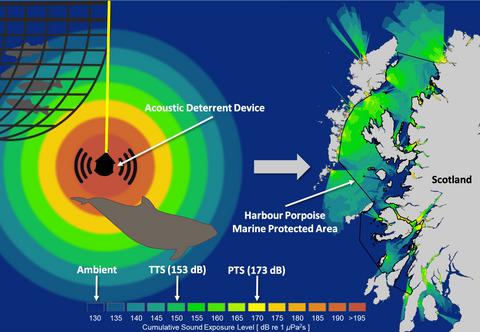当前位置:
X-MOL 学术
›
J. Appl. Ecol.
›
论文详情
Our official English website, www.x-mol.net, welcomes your feedback! (Note: you will need to create a separate account there.)
Auditory impairment from acoustic seal deterrents predicted for harbour porpoises in a marine protected area
Journal of Applied Ecology ( IF 5.7 ) Pub Date : 2021-06-08 , DOI: 10.1111/1365-2664.13910 Charlotte R. Findlay 1 , Dmitry Aleynik 1 , Adrian Farcas 2 , Nathan D. Merchant 2 , Denise Risch 1 , Ben Wilson 1
中文翻译:

海洋保护区内港湾鼠海豚的听觉障碍预测
更新日期:2021-08-04
Journal of Applied Ecology ( IF 5.7 ) Pub Date : 2021-06-08 , DOI: 10.1111/1365-2664.13910 Charlotte R. Findlay 1 , Dmitry Aleynik 1 , Adrian Farcas 2 , Nathan D. Merchant 2 , Denise Risch 1 , Ben Wilson 1
Affiliation

|
- Management interventions to reduce human–wildlife conflict can have unintended consequences for non-target species. Acoustic deterrent devices (ADDs) are used globally by the aquaculture sector. However, the potential for these sound emissions to impact non-target species, such as cetaceans, has not yet been quantified at population relevant spatial scales.
- To better understand the extent of potential impacts on cetaceans, such as harbour porpoises, we used acoustic modelling to investigate levels of ADD noise throughout the west coast of Scotland and across a Special Area of Conservation (SAC) for this species.
- Using an energy-flux acoustic propagation model and data on aquaculture sites known to be using ADDs, we predicted the spatial extent of ADD noise on the Scottish west coast from 1 February 2017 to 31 January 2018. Noise maps were produced to determine the risk of auditory impairment for harbour porpoises under a range of scenarios which assumed single or multiple ADDs and simultaneous use across all sites.
- The acoustic propagation model performed well when tested against field measurements up to 5 km, with 98% of sound exposure level (SEL) predictions within ±10% of the measurements. Predictions of SELs over a 24-hr period suggested extensive temporary hearing loss zones (median radius: ~28 km) for harbour porpoises around aquaculture sites. Assuming a single device at each site, 23% of the harbour porpoise SAC was predicted to be exposed to ADD noise sufficient to induce a temporary threshold shift, and under the worst-case scenario (multiple, continuously running devices per site with an aggregate duty cycle of 100%), levels exceeding permanent threshold shift could reach 0.9% of the SAC.
- Policy implications. This study highlights the potential for ‘collateral damage’ from interventions such as acoustic deterrent devices (ADDs) which are intended to reduce human–wildlife conflicts with pinnipeds but may affect the long-term health and habitat use of non-target species. This is especially true for harbour porpoises which are protected under the EU and UK Habitats Regulations. The aquaculture industry, policymakers and regulators in countries where ADDs are used should consider these findings when attempting to mitigate pinniped depredation.
中文翻译:

海洋保护区内港湾鼠海豚的听觉障碍预测
- 减少人类与野生动物冲突的管理干预措施可能会对非目标物种产生意想不到的后果。水产养殖部门在全球范围内使用声威慑装置(ADD)。然而,这些声音排放影响非目标物种(例如鲸类)的潜力尚未在与种群相关的空间尺度上进行量化。
- 为了更好地了解对鲸类动物(例如港湾鼠海豚)的潜在影响程度,我们使用声学模型来调查整个苏格兰西海岸和该物种的特殊保护区 (SAC) 的 ADD 噪声水平。
- 使用能量通量声学传播模型和已知使用 ADD 的水产养殖场数据,我们预测了 2017 年 2 月 1 日至 2018 年 1 月 31 日苏格兰西海岸 ADD 噪声的空间范围。在假设单个或多个 ADD 并在所有站点同时使用的情况下,港湾鼠海豚的听觉障碍。
- 在针对长达 5 公里的现场测量进行测试时,声传播模型表现良好,98% 的声音暴露水平 (SEL) 预测值在测量值的 ±10% 内。对 24 小时内 SEL 的预测表明,水产养殖场周围的港湾鼠海豚存在广泛的临时听力损失区(中值半径:~28 公里)。假设每个站点有一个设备,预计 23% 的港湾鼠海豚 SAC 会暴露于足以引起临时阈值偏移的 ADD 噪声,并且在最坏的情况下(每个站点有多个连续运行的设备,总负载100% 的循环),超过永久阈值偏移的水平可以达到 SAC 的 0.9%。
- 政策影响。这项研究强调了诸如声威慑装置 (ADD) 等干预措施的“附带损害”的可能性,这些措施旨在减少人类与野生动物与鳍足类动物的冲突,但可能会影响非目标物种的长期健康和栖息地利用。对于受欧盟和英国栖息地条例保护的港湾鼠海豚尤其如此。使用 ADD 的国家的水产养殖业、政策制定者和监管机构在尝试减轻鳍足类掠夺时应考虑这些发现。



























 京公网安备 11010802027423号
京公网安备 11010802027423号